Trim Convert
Trims a surface and converts a four-sided trimmed surface into an untrimmed natural surface.
Access this tool from the Surface Edit tool palette:

Trim Convert Settings
3D Trimming
If this box is checked, you can trim the surface along projected curves and cross sections, or you can select a surface and generate a trimming curve automatically from the intersection with the target surface. By default it is unchecked.
Method
Displays when 3D Trimming is selected.
Project – Creates trimming curves by projecting the selected curves onto the target surface.
Intersect – Creates a trimming curve from the intersection of the selected surface and the target surface.
You can use the Project or Intersect method in a single trimming operation by toggling back and forth between them.
Extend
Extend a curve that does not project entirely on the patch, either automatically or manually, and continue the trim operation without leaving the tool.
Auto
When the trim fails, any curves-on-surface that are within the set Tolerance of another curve-on-surface or boundary are extended and the trim is attempted again.
Selected
A trim extend arrow appears on the curve that needs extending. Clicking the arrow snaps the end of the curve to the patch edge.
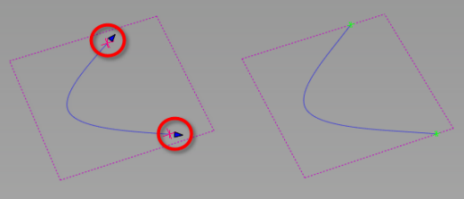
Vector Options
These options are only available if 3D Trimming is turned on.
X, Y, Z
Specifies a projection vector along that axis.
View
Specifies a vector normal to the current view. The vector is not drawn in the view windows.
If the current view is changed, click Refresh View Vector to update the vector.
Picked
Lets you specify the name of an existing vector in the Picked Vector field, or pick the vector in the view.
Normal
The projection is done along the surface normals instead of using a single vector direction.
Picked Vector
This text field only appears when Picked is selected. It displays the name of the selected vector object. Alternatively, you can type in the name of a vector object.
Refresh Vector
This button only appears if View is selected. Click it to update the vector if the view has been modified
Retain Vector
Click this button to create a vector construction object in the view windows.Otherwise, the tool uses the vector direction you specified, but you are not able to see and re-use the vector.
Create Vector
Click this button to create a projection vector.
Click in the view to place the start point of the vector, or type the position and press  . Use the vector manipulator to position the vector then click Accept.
. Use the vector manipulator to position the vector then click Accept.
Control Options
U Degree, V Degree
The degree of the new untrimmed surface in the U and V directions.
U Spans, V Spans
The number of spans of the new untrimmed surface in the U and V directions.
Switch U/V
Turn on this option to change the orientation of the U and V axes on the new trim converted surface.
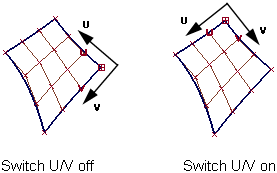
Show Surface Deviation
Displays the maximum deviation between the original trimmed surface and the new untrimmed surface.
Show Edge Deviations
Displays the maximum deviation between each edge of the original trimmed surface and the new untrimmed surface.
Keep Originals
Keep the original trimmed surface after creating the new untrimmed surface.
Auto Update
Automatically updates the surface when you adjust the Trim Convert Settings.
Create Metadata
Specifies whether or not the Trim Convert tool creates history metadata.
Display Options
Show Intersections
If this box is checked, green locators indicate the intersections between the trim curves, and between the trim curves and trim surfaces. Red locators indicate trim curve endpoints that do not intersect any other curve-on-surface or trim surface edge.
Region Selector Length
Adjust the value if the selectors (crosses) appear too small or too large on your model. Displays trim locators based on pixel size rather than based on the size of the surfaces to be trimmed.
Trim convert workflows
Trim convert a surface
Use this tool to trim a surface and converts the four-sided trimmed surface to an untrimmed surface with the same shape.
Select the Trim Convert tool.
Select a surface which has curves-on-surface defining closed regions. You can only trim convert one surface at a time.
Note: If 3D Trimming is turned on, you can either select curves to project onto the surface, or cross sections, to define the trim regions. You can also select a vector option. If you are trimming a surface with its own cross-sections, choose Normal as the vector option.Click on the regions to keep. Make sure that those regions define a four-sided surface.
Crosshairs appear on the selected regions. (The size of those region selectors can be modified through the option window.)
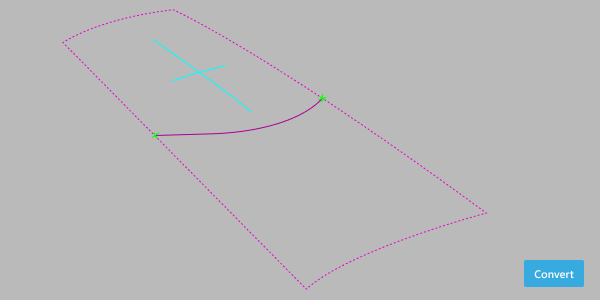
Click the Convert button
The tool trims the surface, then attempts to convert the trimmed surface to a new surface with natural boundaries.
Note: If the trimmed surface is not four-sided, the system issues an error and asks you to redefine the trim region.If Show Surface Deviation is turned on, a locator shows the maximum deviation between the original and the converted surface.
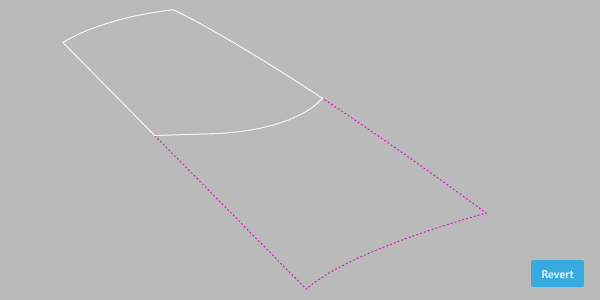
If you are not happy with the result, click the Revert button to get back the original untrimmed surface.
Reshape a NURBS surface so its actual shape resembles its trimmed shape.
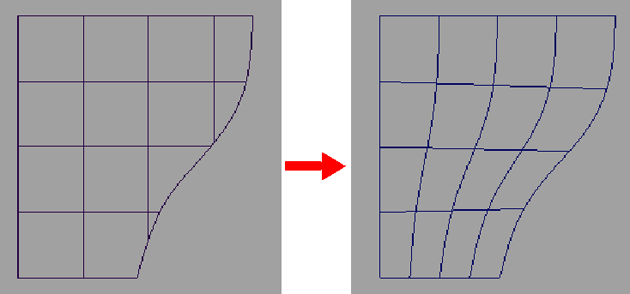
Select the Trim Convert tool.
Click a four-sided trimmed surface.
Note: The Trim convert tool does its best job to match the shape of the trimmed surface with an untrimmed surface. In most cases, an exact match will be impossible.Tip: Turn on the Show Edge Deviations and Show Surface Deviations options to attach deviation locators to the resulting surface to see how much the new surface differs from the original.
